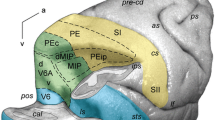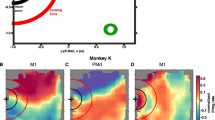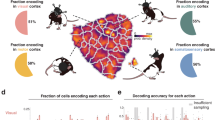Summary
In order to clarify the functional organization of the putamen and the nature of sensory inputs to this structure we studied the relation of single cell activity to active movements and somatosensory stimulation in the awake primate. Neurons (N = 707) were categorized on the basis of their relation to active movements or responses to sensory stimulation of individual body parts. 38% of neurons studied were related to the arm, 9% to the leg, 11% to the mouth or face, and 3% to axial portions of the body. The remaining neurons exhibited non-specific activation which could not be confidently localized to an individual body part (12%) or did not respond during the examination (26%). The high proportion of arm neurons was due to the focus of this study on cells related to arm movements. A large proportion (41%; N = 270) of the “arm” neurons was responsive to somatosensory stimulation. For these neurons the most effective stimulus (82%) was passive joint rotation. Six (5%) of the arm neurons responded to cutaneous stimulation. The putamen was found to be somatotopically organized. Neurons related to different body parts (leg, arm, and face) were segregated, and each body part was represented over a long anteroposterior extent of the nucleus. Clusters of 2–5 neurons with similar relations to active movements or responsive to passive movements of a single joint were often encountered over a 100–500 μ distance. Clusters of neurons with sensory driving were organized by joints. Rather than a single elbow or shoulder area, multiple clusters of neurons related to each joint were widely distributed over a long anteroposterior extent of the nucleus and were adjacent to clusters of neurons related to other joints of the arm. These clusters of neurons with similar functional properties may correspond to the subunits of the striatum which have been revealed by anatomic and morphologic studies. We propose that these clusters of neurons with similar functional properties represent the basic functional units of the striatum in a manner analogous to the functional columns of the neocortex.
Similar content being viewed by others
References
Albe-Fessard D, Rocha-Miranda C, Oswaldo-Cruz E (1960) Activites evoquees dans le noyau caude du chat en response a des types divers differences. II. Etude microphysiologique. Electroencephal Clin Neurophysiol 12: 649–661
Anderson ME (1977) Discharge patterns of basal ganglia neurons during active maintenance of postural stability and adjustment to chair tut. Brain Res 143: 325–338
Anderson FJ, Aldridge JW, Murphy JT (1976) Somatic and visual feedback to monkey caudate nucleus during a central motor program. Soc Neurosci Abstr 2: 59
Asanuma H (1975) Recent developments in the study of the columnar arrangement of neurons in the motor cortex. Physiol Rev 55: 143–156
Crutcher MD, DeLong MR (1981) Relation of putamen neuronal discharge to direction of movement or pattern of muscular activity. Soc Neurosci Abstr 7: 778
Crutcher MD, DeLong MR (1982) Functional organization of the primate putamen. Soc Neurosci Abstr 8: 960
Crutcher MD, DeLong MR (1984) Single cell studies of the primate putamen. II. Relations to direction of movement and pattern of muscular activity. Exp Brain Res 53: 244–258
DeLong MR (1971) Activity of pallidal neurons during movement. J Neurophysiol 34: 414–427
DeLong MR (1972) Activity of basal ganglia neurons during movement. Brain Res 40: 127–135
DeLong MR (1973) Putamen: activity of single units during slow and rapid arm movements. Science 179: 1240–1242
DeLong MR, Georgopoulos AP (1979) Motor functions of the basal ganglia as revealed by studies of single cell activity in the behaving primate. In: Poirier LJ, Sourkes TL, Bedard PJ (eds) Advances in neurology, vol 24. Raven Press, New York, pp 131–140
DeLong MR, Georgopoulos AP (1981) Motor functions of the basal ganglia. In: Brooks VB (ed) Handbook of Physiology. The nervous system. American Physiological Society, Bethesda, pp 1017–1061
Evarts EV (1973) Motor cortex reflexes associated with learned movement. Science 179: 501–503
Fetz EE, Fiaocchio DV, Baker MA, Soso MJ (1980) Sensory and motor responses of precentral cortex cells during comparable passive and active joint movements. J Neurophysiol 43: 1070–1089
Georgopoulos AP, DeLong MR, Crutcher MD (1983) Relations between parameters of step-tracking movements and single cell discharge in the globus pallidus and subthalamic nucleus of the behaving monkey. J Neurosci 3: 1586–1598
Goldman PS, Nauta WJH (1977) An intricately patterned prefronto-caudate projection in the rhesus monkey. J Comp Neurol 171: 369–386
Goldman-Rakic PS (1982) Cytoarchitectonic heterogeneity of the primate neostriatium: subdivision into island and matrix cellular compartments. J Comp Neurol 205: 398–413
Goldman-Rakic PS (1981) Prenatal formation of cortical input and development of Cytoarchitectonic compartments in the neostriatum of the rhesus monkey. J Neurosci 1: 721–735
Graybiel AM, Pickel VM, Joh TH, Reis DJ, Ragsdale CW (1981) Direct demonstration of a correspondence between the dopamine islands and acetylcholinesterase patches in the developing striatum. Proc Natl Acad Sci 78: 5871–5875
Graybiel AM, Hickey TL (1982) Chemospecificity of ontogenetic units in the striatum: Demonstration by combining 3H-thymidine neuronography and histochemical staining. Proc Natl Acad Sci 79: 198–202
Harper JA, Lidsky TI (1977) Trigeminal influences on caudate and substantia nigra units. Soc Neurosci Abstr 3: 38
Hore J, Villis T (1980) Arm movement performance during reversible basal ganglia lesions in the monkey. Exp Brain Res 39: 217–228
Jones EG, Coulter JD, Burton H, Porter R (1977) Cells of origin and terminal distribution of corticostriatal fibers arising in the sensory-motor cortex of monkeys. J Comp Neurol 173: 53–80
Kalil K (1978) Patch-like termination of thalamic fibers in the putamen of the rhesus monkey: an autoradiographic study. Brain Res 140: 333–339
Krauthamer GB (1979) Sensory functions of the neostriatum. In: Divac I, Oberg RGE (eds) The neostriatum. Pergamon Press, Oxford, pp 263–290
Künzle H (1975) Bilateral projections from precentral motor cortex to the putamen and other parts of the basal ganglia. An autoradiographic study in Macaca fascicularis. Brain Res 88: 195–209
Künzle H (1977) Projections from the primary somatosensory cortex to basal ganglia and thalamus in the monkey. Exp Brain Res 30: 481–492
Künzle H (1978) An autoradiograpic analysis of the efferent connections from premotor and adjacent prefrontal regions (areas 6 and 9) in Macaca fascicularis. Brain Behav Evol 15: 185–234
Lemon RN, Porter R (1976) Afferent input to movement-related precentral neurons in conscious monkeys. Proc R Soc Lond [B] 194: 313–339
Lidsky TI, Buchwald NA, Hull CD, Levine MS (1975) Pallidal and entopeduncular single unit activity in cats during drinking. Electroencephal Clin Neurophysiol 39: 79–84
Liles SL (1974) Single-unit responses of caudate neurons to stimulation of frontal cortex, substantia nigra, and entopeduncular nucleus in cats. J Neurophysiol 37: 254–265
Liles SL (1979) Topographic organization of neurons related to arm movement in the putamen. In: Chase TN, Wexler NS, Barbeau A (eds) Advances in neurology, vol 23. Raven Press, New York, pp 155–162
Liles SL (1981) Activity of neurons in the putamen during movement and postural fixation of the arm against external loads. Soc Neurosci Abstr. 7: 778
MacPherson JM, Rasmusson DD, Murphy JT (1980) Activities of neurons in “motor” thalamus during control of limb movement in the primate. J Neurophysiol 44: 11–28
Martin JP (1967) The basal ganglia and posture. Lippincott, Philadelphia
Matsunami K, Cohen B (1975) Afferent modulation of unit activity in global pallidus and caudate nucleus: changes induced by vestibular nucleus and pyramidal tract stimulation. Brain Res 91: 140–146
Neafsey EJ, Hull CD, Buchwald NA (1978) Preparation for movement in the cat. II. Unit activity in the basal ganglia and thalamus. Electroencephal Clin Neurophysiol 44: 714–723
Rosén I, Asanuma H (1972) Peripheral afferent inputs to the forelimb area of the monkey motor cortex: input-output relations. Exp Brain Res 14: 257–273
Schneider JS, Lidsky TI (1981) Processing of somatosensory information in striatum of behaving cats. J Neurophysiol 45: 841–851
Sedgwick EM, Williams TD (1967) The response of single units in the caudate nucleus to peripheral stimulation. J Physiol (Lond) 189: 281–298
Snider RS, Lee JC (1961) A stereotaxic atlas of the monkey brain Macaca mulatta. University of Chicago Press, Chicago
Strick PL (1976) Activity of ventrolateral thalamic neurons during arm movement. J Neurophysiol 39: 1032–1044
Szabo J (1967) The efferent projections of the putamen in the monkey. Exp Neurol 19: 463–477
Wong YC, Kwan HC, MacKay WA, Murphy JT (1978) Spatial organization of precentral cortex in awake primates. I. Somatosensory inputs. J Neurophysiol 41: 1107–1119
Author information
Authors and Affiliations
Additional information
Supported by USPHS grant NS 15417
Rights and permissions
About this article
Cite this article
Crutcher, M.D., DeLong, M.R. Single cell studies of the primate putamen. Exp Brain Res 53, 233–243 (1984). https://doi.org/10.1007/BF00238153
Received:
Issue Date:
DOI: https://doi.org/10.1007/BF00238153




